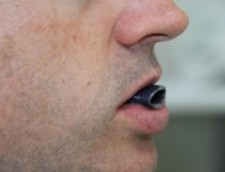May 8 2014
Using a 3D scanner to map a patient’s mouth, CSIRO researchers and Australian dental company, Oventus, can now print a mouthpiece which prevents dangerous pauses in breath during sleep.
 The 3D printed device has a ‘duckbill’ which extends from the mouth like a whistle.
The 3D printed device has a ‘duckbill’ which extends from the mouth like a whistle.
Printed from titanium and coated with a medical grade plastic, the breakthrough mouthpiece is customised for each patient.
The device has a ‘duckbill’ which extends from the mouth like a whistle and divides into two separate airways. It allows air to flow through to the back of the throat, avoiding obstructions from the nose, the back of the mouth and tongue.
Sleep apnoea occurs when the air passage in the throat becomes blocked during sleep and causes people to stop breathing. In severe cases, people can suffer hundreds of events per night.
An estimated one million Australians suffer from the disorder, which can lead to high blood pressure, stroke, irregular heartbeats, heart attacks and diabetes. This number is expected to increase due to growing obesity levels and an aging population.
The existing treatments for sleep apnoea include devices that push the lower jaw forward to open up the airway or in more severe cases; a face mask which creates a continuous flow of air can be used.
CSIRO’s 3D printing expert, John Barnes, said the technology is opening new doors for treatments of a range of medical issues globally.
“When Oventus came to CSIRO with this idea, we were really excited. The possibilities of 3D printing are endless and the fact that we can now design and print a completely customised mouthpiece for patients is revolutionary,” Mr Barnes said.
“It’s an exciting prospect for people suffering from the debilitating disorder and the design offers significant benefits which cannot be achieved with more traditional manufacturing techniques.”
Oventus CEO, Neil Anderson, said the key to the new 3D treatment was in the design.
“This new device is tailored to an individual’s mouth using a 3D scan and is used only on the top teeth which make it more compact and far more comfortable.
“The new 3D printed mouthpiece bypasses all obstructions by having airways that deliver air to the back of the throat and it will also stop patients from snoring,” Mr Anderson said.
The device is expected to be available to patients next year.
CSIRO's additive manufacturing facility, Lab 22, is currently being used to manufacture a range of prototype products including biomedical implants, automotive, aerospace and defence parts for Australian industry.